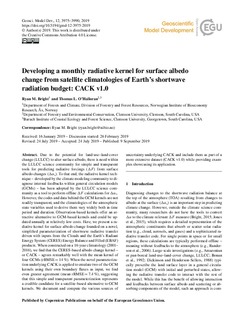| dc.contributor.author | Bright, Ryan M. | |
| dc.contributor.author | O'Halloran, Thomas L. | |
| dc.date.accessioned | 2020-01-13T10:20:27Z | |
| dc.date.available | 2020-01-13T10:20:27Z | |
| dc.date.created | 2019-10-03T12:02:40Z | |
| dc.date.issued | 2019-09-09 | |
| dc.identifier.citation | Geoscientific Model Development. 2019, 12 (9), 3975-3990. | nb_NO |
| dc.identifier.issn | 1991-959X | |
| dc.identifier.uri | http://hdl.handle.net/11250/2635911 | |
| dc.description.abstract | Due to the potential for land-use–land-cover change (LULCC) to alter surface albedo, there is need within the LULCC science community for simple and transparent tools for predicting radiative forcings (ΔF) from surface albedo changes (Δαs). To that end, the radiative kernel technique – developed by the climate modeling community to diagnose internal feedbacks within general circulation models (GCMs) – has been adopted by the LULCC science community as a tool to perform offline ΔF calculations for Δαs. However, the codes and data behind the GCM kernels are not readily transparent, and the climatologies of the atmospheric state variables used to derive them vary widely both in time period and duration. Observation-based kernels offer an attractive alternative to GCM-based kernels and could be updated annually at relatively low costs. Here, we present a radiative kernel for surface albedo change founded on a novel, simplified parameterization of shortwave radiative transfer driven with inputs from the Clouds and the Earth's Radiant Energy System (CERES) Energy Balance and Filled (EBAF) products. When constructed on a 16-year climatology (2001–2016), we find that the CERES-based albedo change kernel – or CACK – agrees remarkably well with the mean kernel of four GCMs (rRMSE = 14 %). When the novel parameterization underlying CACK is applied to emulate two of the GCM kernels using their own boundary fluxes as input, we find even greater agreement (mean rRMSE = 7.4 %), suggesting that this simple and transparent parameterization represents a credible candidate for a satellite-based alternative to GCM kernels. We document and compute the various sources of uncertainty underlying CACK and include them as part of a more extensive dataset (CACK v1.0) while providing examples showcasing its application. | nb_NO |
| dc.language.iso | eng | nb_NO |
| dc.rights | Navngivelse 4.0 Internasjonal | * |
| dc.rights.uri | http://creativecommons.org/licenses/by/4.0/deed.no | * |
| dc.title | Developing a monthly radiative kernel for surface albedo change from satellite climatologies of Earth's shortwave radiation budget: CACK v1.0 | nb_NO |
| dc.type | Journal article | nb_NO |
| dc.type | Peer reviewed | nb_NO |
| dc.description.version | publishedVersion | nb_NO |
| dc.rights.holder | © Author(s) 2019. | nb_NO |
| dc.subject.nsi | VDP::Landbruks- og Fiskerifag: 900 | nb_NO |
| dc.source.pagenumber | 3975-3990 | nb_NO |
| dc.source.volume | 12 | nb_NO |
| dc.source.journal | Geoscientific Model Development | nb_NO |
| dc.source.issue | 9 | nb_NO |
| dc.identifier.doi | 10.5194/gmd-12-3975-2019 | |
| dc.identifier.cristin | 1733399 | |
| dc.relation.project | Norges forskningsråd: 244074 | nb_NO |
| dc.relation.project | Norges forskningsråd: 250113 | nb_NO |
| dc.relation.project | Andre: 2017-68002-26612 -USDA National Institute of Food and Agric. | nb_NO |
| dc.relation.project | Andre: 2017-68002-26612 -USDA NATIONAL INSTITUTE OF FOOD AND AGRIC. | nb_NO |
| cristin.unitcode | 7677,2,0,0 | |
| cristin.unitname | Divisjon for skog og utmark | |
| cristin.ispublished | true | |
| cristin.fulltext | original | |
| cristin.qualitycode | 2 | |

